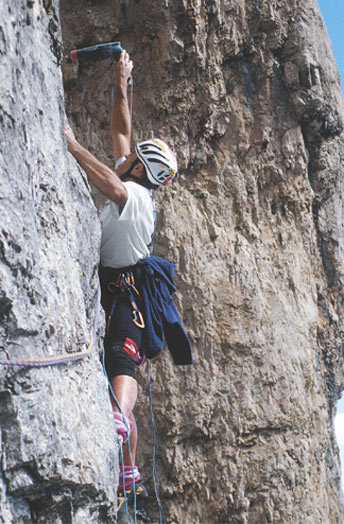
[Photo] Michele Paissan
Climbing is an affliction, and the old virus never dies. At times it may be dormant, even for periods of several years, but when all of a sudden it reappears it is difficult to withstand. There are no vaccines for it; only a big dose of talus fields with heavy packs, plus a storm or two, can alleviate the suffering it causes to its victims.
I haven’t had a summer in which I spent so much time in the mountains since sometime in the 1980s. Luckily this renewed desire for the mountains did not manage to erase within me the fantasy and vision necessary to find a difficult new line. The beautiful Torre Sprit in the Pale di San Martino proved to be the right place to apply my favorite style, which involves free climbing from the ground up, using hooks to place bolts with a powerdrill when necessary, but never resorting to aid for progress.
In Michele Paissan I found the ideal partner, one who was eager to learn and to have new experiences. Soon we were in action, which is always the best of all possible therapies.
I underestimated the Torre Sprit, both in its length and in its difficulty. At first I thought it was about 350 meters high, but soon I realized that the size of the surrounding big walls, with which I had compared it to gauge the size, had tricked me, and that in fact it was closer to 500 meters. On top of that, the difficulties proved to be very sustained. In spite of all of this, in four days of hard work we managed to arrive at the summit.
On the fourth day, Maurizio “Manolo” Zanolla, curious to understand the secrets of our style, kindly gave us a hand. He was very impressed both by the beauty of the tower and that of the route. He hadn’t been to the summit of this tower since 1978, when he had opened a new route just to the right of ours.
Once a route is established, it must receive a redpoint ascent in order to be complete. The first time we tried we arrived at the top of pitch 5 very scared. A storm the night before and two short showers during that day had left many of the long runouts quite wet. We repeatedly climbed a lot of the sections to memorize them for a successful ascent. Now that I had a better idea of what the route would entail, we needed a good weather day, a single rope for the harder pitches, two ropes for the wandering, easier ones, plus fifteen days of sport climbing to gain the necessary fitness–and of course a good dose of luck.
September 14 was the key day. It was a bit cold, and there were some clouds, but I felt very much at ease, climbing up decisively without ever doubting. Everything seemed easy. I do not know if that ease was the result of training, or if it was all just mental determination.
I arrived at pitch 5, an overhanging wall with fifty meters of 5.13a leading to a very dicey crux, in this state of mind. I thought the grade would be somewhere around 5.13c and imagined that I would have to try the pitch several times, but that day everything was different, and I managed to free it immediately, placing the quickdraws on the lead.
At the top of that pitch I rejoiced with Michele. The route was done. The last five pitches were a mere formality. We decided to call our new route La Grande Onda (The Big Wave, 5.13b, 500m) because the wall has a big glacial groove that from a distance, and while climbing, looks like a big wave. I would say that the mandatory climbing is “new age” 5.12b, not because of the difficulty itself, but for the fact that after getting through the hard sections one must keep going, with no bolts in sight for another few meters. Surely this must be another symptom of this damned virus!
— Rolando Larcher, Italy